Skoda Transportation

Visiting address
Emila Škody 2922/1
301 00
Plzeň
Postal address
Emila Škody 2922/1
Plzeň , 301 00
Contact person
Jaromír JelínekJoin our community for FREE today!
Create and share your own profile
Join the discussions
Publish your own items
Subscription to our Weekly eNewsletter
Get connected with Mass Transit Professionals Worldwide
FREE membership benefits
- * create and share your own profile
- * join the discussions
- * publish your own items on Mass Transit Networkmanage news, jobs, tenders, companies, events, showcases, educations, associations and literature.
- * subscribe to our eNewsletter
Company information

ŠKODA TRANSPORTATION is a traditional Czech company engaged in the field of transport engineering, with a strong position in both domestic and world markets. Establishment of ŠKODA TRANSPORTATION is connected with the specialisation restructuring and financial restructuring of the company resulting in acquisition of a strategic owner.
ŠKODA TRANSPORTATION and its subsidiaries are focused on the transport engineering industry, its key products include low-floor trams, electric locomotives, subway trains, suburban train units and trolleybuses, as well as traction motors or complete driving gears for transport systems. The ŠKODA TRANSPORTATION group of companies has more than four thousand employees. Škoda experts develop, produce and supply top products customised to the needs and wishes of its customers.
Company information
301 00 Plzeň
Czech Republic
301 00 Plzeň
Czech Republic
Solutions
- Railbound Vehicles for Public Transport
Product information
Locomotives
 Locomotive Emil Zátoplek
Locomotive Emil Zátoplek
Multi-system Universal Locomotive for Speeds up to 200 km/h
Multi-system Universal Locomotive for Speeds up to 200 km/h.The modern multi-system universal electric locomotive Emil Zátopek follows a long tradition of Škoda production and became the first post-revolution Czech locomotive. This fastest and most efficient domestic locomotive meets all strict technological parameters as well as the latest European safety regulations TSI. Its greatest advantage is its ability to operate in three electrification systems, the operator thus does not have to change the machines in stations. The electric locomotive Emil Zátopek is prepared for the use of the unified European signalling, control and train protection system ECTS, it enables dynamic braking in all electrification systems and it is suitable for operation on curved lines.
The shape of the body is designed to minimize the production of aerodynamic noise and the intensity of the drag at high speeds. Thanks to a four-axle drive Emil Zátopek is the most efficient locomotive of its kind in the world. In the colours of the Czech Railways the locomotive pulls passenger trains on long-distance tracks where it can reach the speed of up to 200km/hour.
 Locomotive Emil Zátoplek Slovakia
Locomotive Emil Zátoplek Slovakia
Multi-system Universal Locomotive for Speeds up to 160 km/h
Multi-system Universal Locomotive for Speeds up to 160 km/h.
In ZSSK variant, the Emil Zátopek locomotive is intended mainly for leading the new ZSSK’s double-deck Push-Pull train-sets. The Emil Zátopek locomotive is primarily intended for operation on tracks not only in the Slovak Republic, but also on the main corridors of the European Union’s electrified lines with 3 kV DC, 25 kV/50 Hz AC and 15 kV/16⅔ Hz AC systems. For maximum interoperability, the locomotive will be equipped with the ETCS L1 and energy consumption measurement.
Four asynchronous traction motors with coiling connected to a double star provide a nominal output of 6400 kW, enabling the Emil Zátopek locomotive to easily reach the speed of 160 km/h. Each of the two inverter boxes contains four pulse rectifiers, pulse brake inverters, and four traction inverters. Water-cooled IGBT modules are used in the inverters. The traction transformer is switchable for 25 kV AC and 15 kV AC systems. During drive on 3 kV DC system, secondary traction coilings are utilized as inductors for the line filter. Even in multiple traction, the TNC-compliant locomotive’s master computer control, together with CRV system and WTB communication, enables control from either locomotive control stand or driving car.
The Emil Zátopek locomotive was designed from the start with respect to the newest TSI safety standards. It is not only because of them that the locomotive complies with the most demanding European railway operation safety requirements.
 Locomotive Emil Zátoplek Germany
Locomotive Emil Zátoplek Germany
A state-of-the-art locomotive for the Deutsche Bahn Regio
A state-of-the-art locomotive for the Deutsche Bahn Regio.
Škoda Transportation will supply the Deutsche Bahn Regio with six new locomotives Emil Zátopek for the track Nuremberg-Ingolstadt-Munich. In the DB these locomotives will bear the designation BR 102. The locomotives will be a part of six six-coach double-deck trainsets of the push-pull type. The trainset can be controlled from the point of the driving trailer or the locomotive. The new locomotive of series BR 102 Emil Zátopek for Germany will have a new design prepared specially for the Deutsche Bahn Regio. Apart from the design the new locomotive will meet traditional functional requirements on locomotives in the Deutsche Bahn Regio. This includes, for example, the function of an automatic brake test.
The locomotive Emil Zátopek meets all strict technological parameters as well as the latest European safety TSI regulations. As a second locomotive in the world it has also received the European certificate TSI High Speed RST.
Tramcars
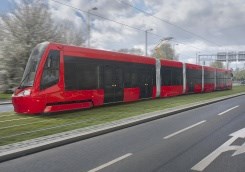 Tramcar Forcity Plus Bratislava
Tramcar Forcity Plus Bratislava
Five bi-directional tram in Bratislava
Trams ForCity Plus are being made by Škoda Transportation for the Slovak capital Bratislava. Their concept is based on the modern ForCity Classic Miskolc trams, which are designed for the Hungarian city of Miskolc. Bratislava’s ForCity Plus trams are bi-directional and low-floored, equipped with modern electronics. Trams are five-sectional and carry up to 350 passengers. The first and last bogies are fully reversible and have a 1000 mm gauge.
Trams offer enough space for passengers, suitable location of restraints and very quiet operation. The vehicles are fully air-conditioned, including the driver’s cabin. For passengers with reduced mobility, a tilting platform is ready. There is also a device for voice communication between the blind passengers and the driver in the vehicle. Of course, there is also a clear audiovisual, information and CCTV system.
 Tramcar Forcity Plus Bratislava
Tramcar Forcity Plus Bratislava
A modern uni-directional, five-section tramcar for the slovak capital Bratislava
The uni-directional tram ForCity Plus is designed for the Slovakian Bratislava. The vehicles are fully air-conditioned and offer a comfortable ride at a high level. The capacity is up to 345 passengers - including 69 seats. Of course there is also a clear visual information system, including devices for voice communication between blind passengers and the driver. For passengers with reduced mobility, a tilting platform is installed, which facilitates entry and exit. The safety of passengers is ensured by a camera system with six indoor and six outdoor cameras.
The concept of the new low-floor trams ForCity Plus is based on the modern trams ForCity Classic Miskolc, that are already operated in the Hungarian city of Miskolc. The vehicles have five sections and a track gauge of 1000 mm. The first and last body chassis is fully rotatable. The maximum speed of the vehicle is 65 km/h.
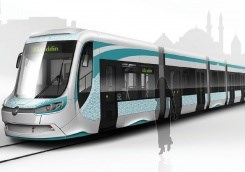 Tramcar Forcity Classic Konya - Battery
Tramcar Forcity Classic Konya - Battery
The tramcar uses a battery-powered drive
During 2015, twelve unique “catenary-free” tramcars will be delivered to the ancient Turkish city of Konya (with a population of over 1.1 million). These tramcars are the ForCity Classic type and they are equipped with a state-of-the-art traction battery powered drive which allows them to operate independently of overhead lines. The vehicles will be operated on a newly built route which has a total length of 6 km, of which approx. 2 km will be without overhead lines. The Škoda company will use state-of-the-art high-power batteries in these tramcars for the Turkish city of Konya. Škoda Transportation also offers an alternative solution using a combination of traction batteries and super capacitors.
The battery powered drive of tramcars is used mainly in cases when a tramcar passes through an area where it is impossible to install a power supply trolley, for example, due to aesthetic reasons in historical city centres. The battery powered drive can also be used when a tramcar needs to leave a frequented place in the case of a fault on the overhead power lines so that it will not obstruct the road traffic. The batteries of a battery powered tramcar are located in special roof containers where batteries of various types and capacities can be installed according to the required nature of the operation. The battery is recharged while the tramcar is moving under a trolley, for example, when driving on a section of a route which is fitted with overhead lines or while standing in a depot.
 Tramcar Forcity Classic Konya
Tramcar Forcity Classic Konya
Fully low-floor tramcar for the Turkish city of Konya
The Škoda Transportation Company produces a 100% low-floor tramcar for the Turkish city of Konya. The new vehicle conception is based on the tram ForCity Classic for the Hungarian city of Miskolc. This fully low-floor bi-directional tram is equipped with modern electronics. The difference consists for example in the vehicle body that is longer and narrowed by 100 mm down to 2,55 m. The central undercarriage is equipped with a parking brake and front rear-view mirrors on both sides of the driver’s compartment. The air-condition system has been adapted to climatic conditions in Turkey. Unique is especially the design inspired by the motifs of Islamic architecture and the world uniqueness of the city of Konya –whirling Dervishes.
The fully low-floor five-section tram Škoda ForCity Classic Konya complies with the latest European safety standards. The tram has low operating costs because it takes advantage of energy recuperation when braking. Because the electric equipment is placed on the roof of the vehicle and the tram is more than 32 meters long, it can offer space for up to 364 passengers. The fully low-floor design and the low boarding edge allow easy getting on and off even for disabled persons. The air-condition system as well as well-arranged information system contribute to the comfort of the passengers.
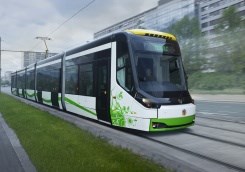 Tramcar Forcity Classic Miskolc
Tramcar Forcity Classic Miskolc
Fully low-floor bidirectional tramcar for hungarian city of Miskolc.
Škoda Transportation produced a 100% low-floor bi-directional tram for the Hungarian city of Miskolc. The vehicle follows a series of bi-directional vehicles which became popular among the passengers in the Italian city of Cagliari, American Portland or Polish Wroclaw. Fully low-floor five-section Škoda ForCity Classic meets the latest European safety standard which guarantees greater safety for both the passengers and the driver in the case of a possible accident.
Easily accessible electric equipment is located on the roof of the vehicle, during braking there is energy recuperation which together with the asynchronous traction motors reduces the costs of operation and maintenance. The tram Škoda ForCity Classic has a wider body than the previous types and can offer space for up to 300 passengers. The overall low-floor design and boarding edge at the height of 330 mm above the top of rail allows easy boarding and exiting of passengers. The platforms next to the doors offer enough space for bicycles, prams or persons with reduced mobility. Air-conditioning and a clear information system also contribute to the comfort of passengers.
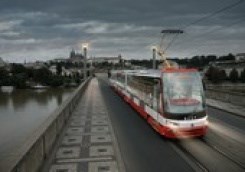 Tramcar Forcity Alfa Prague
Tramcar Forcity Alfa Prague
100% low-floor uni-directional three-section tramcar
The fully low-floor tram ForCity Alfa represents a new generation of modern vehicles in municipal transport; it combines elegance, dynamics and the latest technologies. ForCity Alfa is designed in such a way as to cope with the most demanding profiles of railway networks without any problems, and it does so also thanks to the individual wheel drive. The greatest advantage of the ForCity Alfa tram are pivoting bogies which are friendly to tracks and reduce the maintenance costs of the vehicle and the infrastructure. The optimum speed is controlled by a computer according to the number of passengers, condition of the track and profile of the route. The tram ForCity Alfa has a wheel slip and wheel slide protection.
In comparison with older trams the operation of the ForCity Alfa tram is much quieter thanks to the direct wheel drive without gearboxes and special tyres with absorbing rubber inserts. An entry space without stairs makes boarding and exiting easier for families with prams or passengers with reduced mobility. A clear information system, easily accessible control buttons of doors or for example a communication link with the cabin of the driver contribute to the comfort of passengers. Ergonomically shaped wooden seats which were chosen by passengers themselves in a survey constitute also an innovation.
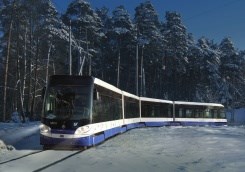 Tramcar Forcity Alfa Riga
Tramcar Forcity Alfa Riga
100% low-floor uni-directional three-section tramcar
The fully low-floor tram ForCity Alfa Riga, produced by Škoda Transportation for the Latvian capital city, represents a new generation of modern vehicles in the municipal public transport. It embodies elegance, dynamics and the latest technologies. The tram ForCity Alfa is designed to cope with the most demanding profiles of railway networks without any problems, and it does so also thanks to the individual wheel drive.
Pivoting bogies which are friendly to the tracks and reduce the maintenance costs of the vehicle and the infrastructure are a noticeable feature of the tram ForCity Alfa. Thanks to the modular design of the tram ForCity Alfa, it was possible to easily adjust the version for Riga to a greater track gage (1,524 mm). The less demanding profile of the routes in Riga makes it possible for the ForCity Alfa tram to have only three traction bogies. The optimum speed is controlled by a computer according to the number of passengers, condition of the track and profile of the route. The tram ForCity Alfa has a wheel slip and wheel slide protection.
ForCity Alfa is very quiet due to special wheel tyres with absorbing rubber inserts. An entry space without stairs makes boarding and exiting easier for passengers with prams or with reduced mobility. Air-conditioning in the whole tram, a clear information system, easily accessible control and communication buttons and other safety features improve the travelling by public transport and contribute to the comfort of passengers.
Electric Multiple Units
 Single Deck Electric Unit Regiopanter
Single Deck Electric Unit Regiopanter
Single deck electric units represents new generation of low-floor vehicles with max. Speed 160 km/h
The electric single-floor unit RegioPanter represents a completely new generation of modern low-floor vehicles which offer high quality of travelling. The main train unit most often consists of a two- to three-car formation but if it is necessary to increase the transport capacity, it is possible to connect up to four units by means of the automatic coupling. All cars are equipped with a driving bogie with two asynchronous motors and one regular bogie. In contrast to the current two-car trains, RegioPanter consumes up to half less electricity, and it does so also thanks to a recuperation system of energy which is produced during braking. The single-floor regional unit is conceived as completely walk-through, i.e. without inner partitions and doors. Even the passage between the cars is open. Most of the electric equipment is located on the roof, and this has significantly increased the space for the passengers.
RegioPanter is intended primarily for regional tracks where passengers will certainly appreciate comfortable and cosy seats, air-conditioning or Wi-Fi connection. Barrier-free boarding through wide doors which are equipped with folding footboards to suit different heights of platforms is taken for granted. Inside the train there is sufficient space for wheelchair users, bicycles or prams. A clear information system and notices for blind persons make orientation easier for passengers in train units produced in the company Škoda Transportation and Škoda Vagonka.
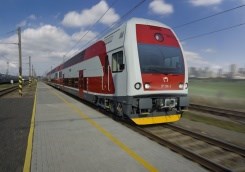 Electric Multiple Units Series 671 Slovakia
Electric Multiple Units Series 671 Slovakia
Electric unit series 671 is designed for suburban traffic in vicinity of large cities in Slovakia
Škoda Vagonka produces two-floor multi-system electric units of series 671 for the Slovak railways, these units are intended for commuter transport particularly in the outskirts of Trenčín, Košice and Žilina. The construction solution proceeds from electric units of series 471 and 575 which are driven in the Czech Republic and Lithuania. A three-car formation consists of an electric car of series 671, driving car of series 971 and intermediate car of series 071. Thanks to the automatic coupling it is possible to connect and control up to four units during the rush hour. This train unit is equipped with multi-system electric equipment and is prepared for the European signalling, control and train protection system (ETCS).
Modern car equipment and low level of interior noise contribute to comfortable travelling. Seats are coupled 2 + 2 and each double seat is equipped with a power point. There is also an effective system of ventilation, heating and air-conditioning. The electric and driving cars are equipped with drop down ramps for passengers on wheelchairs. Wide low-floor doors also enable fast and comfortable exiting and boarding. All areas are monitored by fire sensors, and engine rooms are equipped with an automatic fire extinguishing system. Passengers will also appreciate a clear information system.
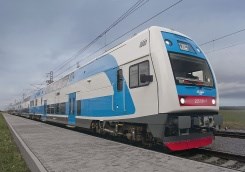 Electric Multiple Units Series 675 Ukraine
Electric Multiple Units Series 675 Ukraine
Electric double deck unit is designated for inter-regional traffic primarily in Ukraine
Škoda Vagonka and Škoda Transportation have produced a new electric two-floor unit of series 675 for Ukrainian tracks. This type is intended primarily for interregional transport on Ukrainian tracks with a gage of 1,520 mm. Due to significant distances passengers will certainly appreciate the maximum speed of 160 km/hour. The cars of the unit are specially modified to withstand demanding climate conditions in Ukraine with a temperature range of ± 40 °C. It is a multi-system unit which consists of six cars (two motor cars of series 225 and four intermediate cars of series 227). The car can be, however, connected to one more unit, and this will lead to a significant increase in the capacity at the time of the rush hour. The control microprocessor system enables a single engine driver to control the train formation.
The modern open-plan interior of the 1st and 2nd class, comfortable seats, air-conditioning, Wi-Fi connection to the Internet, vending machines or television screens significantly increase the comfort of passengers. Barrier-free boarding through wide doors, which make travelling easier not only for people with reduced mobility but also for families with prams, and sufficient space for comfortable travelling are taken for granted. Moreover, every motor car guarantees eight places for bicycles.
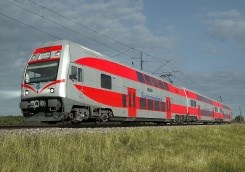 Electric Multiple Units Series 575 Lithuania
Electric Multiple Units Series 575 Lithuania
Electric unit class 575 provides new quality of travelling for passengers on tracks in Lithuania
Škoda Vagonka produces a two-floor electric unit of series 575 for Lithuanian railways. This train unit is intended for commuter transport on electrified tracks with a gage of 1,520 mm where it drives at the speed of up to 160 km/hour. The basic formation of the electric unit has three cars and consists of an electric car of series 211, an intermediate car of series 444 and a driving car of series 307, or possibly it can have only two cars (without an intermediate car). The construction solution and main dimensions of all cars are identical. The unit is equipped with automatic coupling which enable connection and control of up to four units according to the operational need.
The modern open-place interior, low-floor boarding through wide doors, air-conditioning, lifting platform for passengers on wheelchairs and other information and safety features increase the comfort of passengers. Boarding ramps, drop down footboards and barrier-free spaces including a WC fitted with the Braille signage make travelling easier even for handicapped persons. An internal and external CCTV system is used to increase the safety of passengers. The units are also equipped with facilities for connecting to the Internet
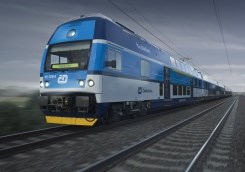 Electric Multiple Units Series 471 Cityelefant
Electric Multiple Units Series 471 Cityelefant
Electric unit 471 represents the first type of new generation of advanced double-deck vehicles
Since 1997 Škoda Vagonka has been producing two-floor electric units of a new generation which have introduced modern, comfortable and safe travelling into commuter transport. The electric two-floor unit of series 471, known under the name “CityElefant”, is today produced in its already fourth generation which meets the latest safety standards. Modern features and the latest technology guarantee comfortable travelling to passengers. The basic formation of the electric unit has two or three cars, it consists of an electric car of series 471, driving car of series 971 and possibly an intermediate car of series 071. Their construction solution and main dimensions are identical. If it is necessary to increase the transport capacity, it is possible to use the automatic coupling to connect up to four units. The body of the vehicle which is made of large aluminium parts significantly reduces the weight of the units and increases their service life. Four asynchronous traction motors together with an electrodynamic brake with a recuperation option reduce the energy intensity of operation.
The open-space interior, low-floor boarding through wide doors, air-conditioning, lifting platform for passengers on wheelchairs and other information and safety features increase the comfort of passengers. The success of these electric units in the Czech Republic led to the development and manufacture of units of a similar type for foreign markets.
Metro
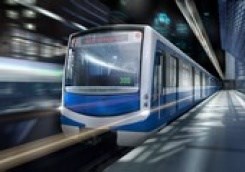 Metro st. Petersburg
Metro st. Petersburg
Modern metro train-set for 1524 mm gauge
Škoda Transportation has produced a modern underground train unit for the Russian city of St. Petersburg with a gage of 1,520 mm. The six-car formation consists of two identical train parts which are connected by their rear ends. Both parts consist of a motor car with the compartment of the engine driver 18 Mt, intermediate motor car 19 Mt and intermediate car without a drive 20 Mt. The motor car is equipped with a control computer, traction container, pneumatic brake, battery, and the intermediate motor car has also a compressor unit. The intermediate car is also equipped with a control computer and a pneumatic brake. Most of the electric equipment for the drive of the unit is located in the traction container which is suspended below the floor of the motor cars.
Ventilation units which apart from providing pleasant lighting also increase the comfort of travelling byPetersburg undergroundare located in each carriage. An audiovisual information system which is supplemented with loudspeakers of the train PA system helps to keep the passengers informed. The safety of the passengers and driver is provided by means of a modern CCTV system with data recording. The main advantage of the unit is its lower weight, by as much as a quarter of the weight of current cars. The lighter cars can also use recuperation of energy during braking and they can save up to forty percent of electric energy compared to the cars in operation today.
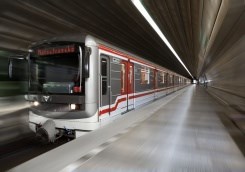 Modernized Metro 81-71m
Modernized Metro 81-71m
Comprehensive metro train-sets modernization in Prague
Škoda Transportation has carried out an extensive and complex modernization of original Russian cars of the Prague underground. New five-car formations 81 - 71 M which travel on the underground routes A and B consist of two front cars (2 Mt), an intermediate car with batteries (3 Mt) and intermediate cars with a compressor (4 Mt). Thanks to the reconstruction it was possible to improve the safety both of passengers and the driver, to increase the service life of cars and to make maintenance and operation more effective so that the modernized units will have comparable parameters with new vehicles. At the same time the comfort of passengers was significantly improved.
The front part of the vehicle, including the compartment of the engine driver, underwent significant change. The reconstructed cars were equipped with new efficient compressors, pneumatic equipment including air dryers or computer control. The cars have a modern traction drive with energy recuperation during braking. They also meet the latest safety regulations including the requirement for fire resistance and toxic-free floors, inner cladding or used cables. Each car is equipped with a modern fire alarm system. The interior of cars is conceived in a completely innovative way, it provides sufficient comfort to both sitting and standing passengers, and a clear information system is taken for granted
 Type 81-553 Metro Trainsets
Type 81-553 Metro Trainsets
Metro trainsets for kiev and kazan, for which skoda makes complete modern traction equipment
In cooperation with a Russian partner Škoda Transportation produces new underground train units for the cities of Kiev (a five-car unit consisting of two cars 12 Mt – front, one car 13 Mt – intermediate regular, and two cars 14 Mt – intermediate driving) and Kazan (a four-car unit consisting of two cars 12 Mt – front, one car 13 Mt – intermediate regular, and one car 14 Mt – intermediate driving) where Škoda Transportation takes part in supplying traction and pneumatic equipment.
Most of the electric equipment intended for the drive of the formation is located in the traction container which is suspended below the floor. Every traction container contains four traction inverters each of which is used for the power supply of a separate traction motor. The three-phase asynchronous traction motors are equipped with their own cooling. This guarantees trouble-free operation of the units also in above-ground sections.
Trolleybuses
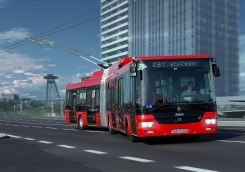 Trolleybus 31 TR
Trolleybus 31 TR
Full low-floor 18 meter length articulated trolleybuses
Škoda Electric in Plzeň, together with the company SOR Libchavy, produced a 12-metre fully low-floor four-door trolleybus which is intended for municipal public transport with operation on the voltage of 600 or 750 V DC. The first trolleybus Škoda 30 Tr SOR was produced in 2010. Škoda Electric supplies all electric equipment and carries out the overall assembly of this two-axle vehicle. The electric equipment is located in a container on the roof of the vehicle. The trolleybus can be also equipped with an auxiliary diesel generator which is located in the rear part of the vehicle and which makes it possible to drive the vehicle even in places lacking trolley lines. An asynchronous traction motor and a voltage inverter controlled by a microprocessor with a recuperation option significantly reduce the energy intensity of operating the vehicle and its maintenance costs.]
The comfort of passengers is improved by the overall low-floor design of the vehicle and by wider aisles between the seats. Boarding and exiting of passengers is made easier by means of the so-called kneeling when the trolleybus tilts to the edge of the pavement. An efficient system of heating and a clear information system also improve the comfort of passengers. There is also a tilting platform for wheelchair users. The trolleybuses Škoda 30 Tr SOR are operated in Hradec Králové and Bánská Bystrica.
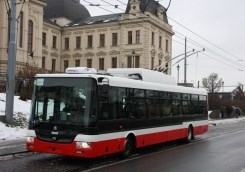 Trolleybus 30 TR
Trolleybus 30 TR
Full low-floor 12 meter length trolleybuses
Škoda Electric in Plzeň, together with the company SOR Libchavy, produced a 12-metre fully low-floor four-door trolleybus which is intended for municipal public transport with operation on the voltage of 600 or 750 V DC. The first trolleybus Škoda 30 Tr SOR was produced in 2010. Škoda Electric supplies all electric equipment and carries out the overall assembly of this two-axle vehicle. The electric equipment is located in a container on the roof of the vehicle. The trolleybus can be also equipped with an auxiliary diesel generator which is located in the rear part of the vehicle and which makes it possible to drive the vehicle even in places lacking trolley lines. An asynchronous traction motor and a voltage inverter controlled by a microprocessor with a recuperation option significantly reduce the energy intensity of operating the vehicle and its maintenance costs.
The comfort of passengers is improved by the overall low-floor design of the vehicle and by wider aisles between the seats. Boarding and exiting of passengers is made easier by means of the so-called kneeling when the trolleybus tilts to the edge of the pavement. An efficient system of heating and a clear information system also improve the comfort of passengers. There is also a tilting platform for wheelchair users. The trolleybuses Škoda 30 Tr SOR are operated in Hradec Králové and Bánská Bystrica
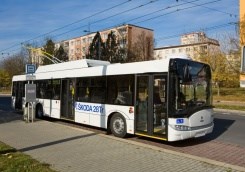 Trolleybus 28 TR
Trolleybus 28 TR
Full low-floor 15 meter length trolleybuses type škoda 28 tr solaris
Škoda Electric in Plzeň, together with the Polish company Solaris, produced a unique 15-metre fully low-floor three-door trolleybus which is intended for municipal public transport with operation on lower or higher electrification (600 or 750 V DC). The first trolleybus Škoda 28 Tr Solaris was produced in 2008. Škoda Electric supplies all electric equipment and carries out the overall assembly of this three-axle vehicle. The electric equipment is located in a container on the roof of the vehicle. The trolleybus can be also equipped with an auxiliary diesel generator which is located in the rear part of the vehicle and which makes it possible to drive the vehicle even in places lacking trolley lines. An asynchronous traction motor and a voltage inverter controlled by a microprocessor with a recuperation option significantly reduce the energy intensity of operating the vehicle and its maintenance costs.
The comfort of passengers is improved by the overall low-floor design of the vehicle and by wider aisles between the seats. Boarding and exiting of passengers is made easier by means of the so-called kneeling when the trolleybus tilts to the edge of the pavement. An efficient system of heating and a clear information system also improve the comfort of passengers. There is also a tilting platform for wheelchair users. The trolleybuses Škoda 28 Tr Solaris are operated in Pardubice, Teplice and Ústí nad Labe
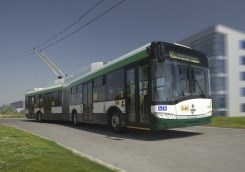 Trolleybus 27 TR
Trolleybus 27 TR
Full low-floor 18 meter length articulated trolleybuses
Full low-floor articulated three-axle four door trolleybus designated for public transport, vehicles should operate on system nominal voltage between 600 and 750 VDC. Entrance step height at front and second door is 320mm, at other door is 330mm; it allows comfort entrance of persons into vehicle. Complete accessibility is provided by ramp located in second door space. The floorage of the vehicle is completely 100% low-floor without any steps. Anticorrosive protection of trolleybus shell is provided by rustless material.
Electrical traction equipment is located in easily accessible compact container on the roof of the vehicle. Asynchronous traction motor and microprocessor-controlled voltage inverter with possibility of recuperation expressively reduce energetic consumption and maintenance costs for the vehicle operation.
Traction motor is asynchronous forced ventilation, maintenance free only with changes of bearing.
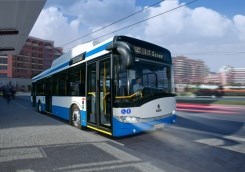 Trolleybus 26 TR
Trolleybus 26 TR
Full low-floor 12 meter length trolleybuses
Full low-floor two-axle three door trolleybus designated for public transport, vehicles should operate on system nominal voltage between 600 and 750 V DC. Entrance step height at front and second door is 320mm, at other door is 330mm; it allows comfort entrance of persons into vehicle. Complete accessibility is provided by ramp located in second door space. The floorage of the vehicle is completely 100% low-floor without any steps. Anticorrosive protection of trolleybus shell is provided by rustless material.
Electrical traction equipment is located in easily accessible compact container on the roof of the vehicle. Asynchronous traction motor and microprocessor-controlled voltage inverter with possibility of recuperation expressively reduce energetic consumption and maintenance costs for the vehicle operation.
Traction motor is asynchronous forced ventilation, maintenance free only with changes of bearing
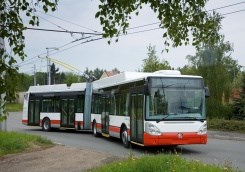 Trolleybus 25 TR
Trolleybus 25 TR
Full low-floor 18 meter length articulated trolleybuses
Full low-floor articulated three-axle four door trolleybus designated for public transport, vehicles should operate on system nominal voltage between 600 and 750 V DC. Entrance step height at front door is 320mm, at other doors 330mm; it allows comfort entrance of persons into vehicle. Complete accessibility is provided by ramp located in second door space. The floorage of the vehicle is completely 100% low-floor without any steps. Anticorrosive protection of trolleybus shell is provided by cataphoresis.
Electrical traction equipment is located in easily accessible compact container on the roof of the vehicle. Asynchronous traction motor and microprocessor-controlled voltage inverter with possibility of recuperation expressively reduce energetic consumption and maintenance costs for the vehicle operation.
Traction motor is asynchronous forced ventilation, maintenance free only with changes of bearing.
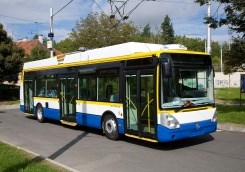 Trolleybus 24 TR
Trolleybus 24 TR
Full low-floor 12 meter length trolleybuses
Full low-floor two-axle three door trolleybus designated for public transport, vehicles should operate on system nominal voltage between 600 and 750 V DC. Entrance step height at front door is 320mm, at other doors 330mm; it allows comfort entrance of persons into vehicle. Complete accessibility is provided by ramp located in second door space. The floorage of the vehicle is completely 100% low-floor without any steps. Anticorrosive protection of trolleybus shell is provided by cataphoresis.
Electrical traction equipment is located in easily accessible compact container on the roof of the vehicle. Asynchronous traction motor and microprocessor-controlled voltage inverter with possibility of recuperation expressively reduce energetic consumption and maintenance costs for the vehicle operation.
Traction motor is asynchronous forced ventilation, maintenance free only with changes of bearing
For more products: http://www.skoda.cz/en/products/
Press releases
- More trams from Plzeň-based Škoda will be operating in Brandenburg
- New Skoda Transportation Electric Buses for Prague
- The Škoda Transportation Group will acquire Evoka Electric
- Škoda Vagonka wins contract for supply of electric trains for Latvia
- The last tram was delivered to Prague
- Škoda Transportation presented first tram for German city Chemnitz
- Škoda Transportation receive certification for HS trains for Germany
- Škdoa Transtech sells Artic trams to German Schöneiche
- České dráhy ordered 50 modern express vehicles from Siemens-Skoda
- Škoda will deliver 80 trams to Germany
- Transtech will deliver 10 new ForCity Smart Artic trams to Helsinki
- Škoda Electric presents its new electric bus
- Škoda Transportation will deliver new trams to Bulgaria
- Škoda Transportation Group will deliver new wagons to national Finnish carrier VR worth over 50 Million Euro
- A trolleybus from Škoda Electric has been put into service in Mexico City
- Škoda Electric has succeeded in Brazil
- Škoda Transportation Group succeeded in Finland
- Škoda Transportation has received a new order in Turkey for modern battery-powered trams
- Another significant success for Škoda Transportation Trams from Pilsen head for German Chemnitz
- Škoda Transportation celebrates an important export achievemnt in Latvian Riga
- First Škoda 109E locomotive for DB on test
- Positive development in the largest Czech contract with Germany
- The first serial Škoda Tramcar rolled out at Otanmäki Rollings Stock Plant
- The first Czech battery-powered-tram intended for Turkey will appear in Pilsen



